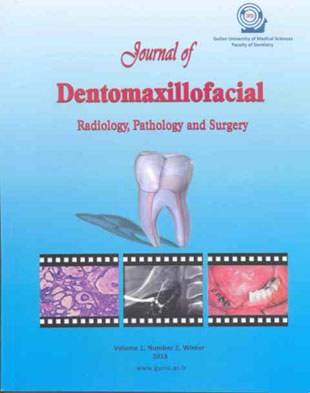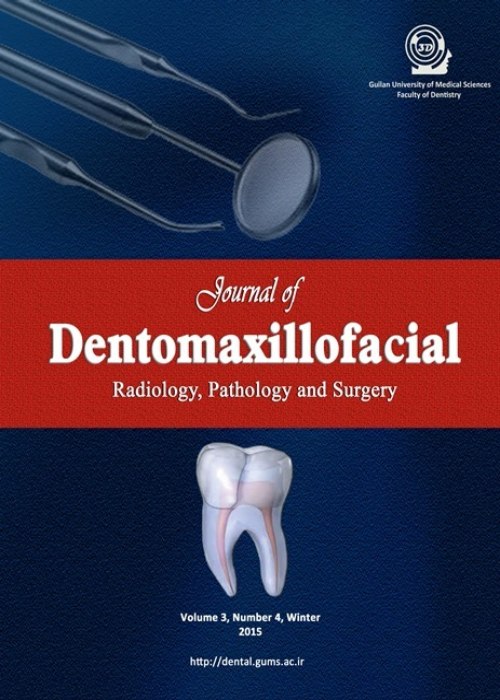فهرست مطالب

Journal of Dentomaxillofacil Radiology, Pathology and Surgery
Volume:2 Issue: 2, Summer 2013
- تاریخ انتشار: 1392/07/13
- تعداد عناوین: 6
-
-
Page 1IntroductionDiagnosis, prediction and control of oral lesions is usually done classically basedon clinical signs and histopathologic features. Due to lack of timely diagnosis in allconventional methods or differential diagnosis, biopsy of patient is needed. Therefore, the patient might be irritated. So, an intelligent method for quick and accurate diagnosis would be crucial. Intelligent systems approach has been successful in prediction and diagnosis of factors. Intelligent instruments significantly contributed to the diagnosis of different disease, such as timely diagnosis of breast cancer, heart failures and so on. In this research, three of the most common and relatively dangerous oral diseases (lichen planus, leukoplakia and squamous cell carcinoma) have been studied using intelligentsystems based on artificial neural networks (ANN).Materials And MethodsIn this study, thepopulation of the study constituted one hundred and fifty, fifty patients are considered in each disease. The four features for learning intelligent systems given to it as an input.ResultsThe output of this system includes charts and tables to determine the optimal prediction of machine. One of the figures represents the descent of error that is convergent to the global optimum. The extreme prediction of machine would be achievable with the least amount of attention. So, the credibility and reliability will be boosted.ConclusionThe purpose of this research is the application of artificial intelligence techniquesin branch of dentistry to the aim of early diagnosis and treatment of oral diseases.Keywords: Prediction, Lichen Planus, Leukoplakia, Carcinoma, Squamous Cell, Artificial Neural Network
-
Page 9IntroductionRetention of fiber reinforced composite posts depends on the bond strengthbetween post and cement, and cement and root dentin. The aim of this study is to evaluatethe bond strength of one type of fiber post to radicular dentin with different adhesive cements.Materials And MethodsCrowns of 44 cariesfree, human premolar were removed 2 mm belowthe CEJ and the roots were endodontically treated, then prepared for post cementation. The samples were randomly divided into 4 groups, group 1: Breeze (self-adhesive), group 2: ED Primer II/Panavia F2 (self-etch), group 3:Prime & Bond NT dual-cure /All-Cem (etch & rinse), and group 4: GC Fuji Plus.After post cementation and composite filling of coronal portion(as manufacturers,s instruction)and thermocycling, each specimen was cut into 2 mm thickness from the middle third of theroot and the push-out bond strength test was performed and failure modes were recorded. Data were analyzed employing ANOVA and post hoc tests (P value< 0.05).ResultsGroup 4 showed significantly the highest bond strength (12.88±3.44 MPa), while group 1 showed significantly lower bond strength than the other groups (5.25±2.98MPa). Also a statistically significant difference was observed between groups 2 and 3 with group 4.(P value<0.021)ConclusionRetention of fiber post was affected by cement type. The results also indicated that in GC Fuji Plus the chemical interactions be tween the cement and hydroxyapatite may be important for root dentin bonding. Breeze without any pretreatment procedure cannot obtain the acceptable bond strength.Keywords: Adhesive cement, Dental bonding, Light, cured
-
Page 18IntroductionMedical claim is one of the most concerning subjects for both patients and physicians. In addition, it has lots of financial and nonfinancial costs for health care systems. To define the number and causes of medical claims against dentists of Rasht since 2006 till 2011in Guilan medical council.Materials And MethodsA retrospective cross - sectional study was performed since 2006 till 2011.To collect the initial data, a check list has been designed, including demographic data of patients, claims against physicians and results on their counseling. All data have been collected and analyzed employing descriptive methods.ResultsIn this study, 69 claims were recorded in 6 years which mostly were due to malpractice, treatment complications and financial issues.ConclusionGiving patients sufficientinformation about the illness, treatment methods, probable complications and avoiding financial issues between patients and dentists can help decrease the medical claims and would result in more reliance.Keywords: Medical claim, Malpractice, Dentis
-
Page 23IntroductionOptimal radiopacity is one of the properties required for a root canal sealer that helps the distinction between the sealer and surrounding anatomic structures and evaluation of the quality of root filling. So, the purpose of this study was to evaluate the radiopacity of six root canal sealers at different focal distances.Materials And MethodsIn this in vitro study, six endodontic sealers (ADSEAL, AH26, AH plus, Dorifill, MTA fillapex, and ZOE), were prepared and placed in a mold with 1mm thickness and10mm diameter. The specimens were positioned alongside an aluminum step wedge on a digital detector (occlusal size 76×57 mm). Radiographic imaging was performed at 15 and 30cm focal distances and radiopacity of each specimen was measured.One-way ANOVA and paired t-test were used and p<0.05 was considered significant.ResultsAll sealers were found to be more radiopaquethan 3 mm aluminum. At 15cm focal distance, the radiopacity values were 31.7, 60.68, 121.48, 52.4, 48.6, and 48.08 aluminum for ADSEAL, AH26, AH plus,Dorifill, MTA fillapex and ZOE, respectively. At 30cm focal distance, the figures were 80.32, 153.6, 253.6, 139.92, 144.08, and 129.92 for ADSEAL, AH26, AH plus,Dorifill, MTA fillapex and ZOE, respectively.ConclusionAll of the sealers investigated in this study met the standards for minimal radiopacity. AH plus had the highest radiopacity at both focal distances. Radiopacity decreased by increasing the focal distance and the decline was statistically significant for AHplus.Keywords: Endodontic, Digital, Radiography
-
Page 28IntroductionMineral trioxide aggregate (MTA) as an alternative material to gutta-percha for obturation of root canal in special cases has several drawbacks. The purpose of this study was to compare the apical sealing ability of a new MTA-based sealer versus MTA.Materials And MethodsA total of 36 canals of extracted maxillary central incisors were instrumented and randomly divided into 3 experimental groups (n=10) and two negative and positive control groups (n=3). Lateral compaction technique was performed using AH26 sealer (group 1 or control), and MTA Fillapex (group 2). The canals in group 3 were filled using vertical compaction of MTA alone. Sealing ability was evaluated using dye leakage penetration method. Data was analyzed by one way ANOVA and LSD (Least Significant Difference) test.ResultsThe observed leakage in groups 2 and 3 which were filled with MTA Fillapex and MTA orthograde was significantly different from the control group which were filled with AH26 sealer (P=0.015, P=0.001). There was no significant difference between group 2 and 3which was filled with MTA Fillapex and MTA orthograde (P=0.205).ConclusionWithin the limitation of this in vitro study, there was no significant difference between apical sealing ability of MTA Fillapexand MTA orthograde.Keywords: Canal Scaler, Mineral Trioxide Aggregate, Obturation, Root Canal
-
Page 32IntroductionThe use of panoramic radiography has shown a remarkable expansion over thepast 20 years. Accurate positioning and preparation of patients is needed to avoid image distortion. The aim of this study was to evaluate the common errors on panoramic radiographs taken in the radiology department of Rasht dental school.Materials And MethodsThe study sample included 390 digital panoramic radiographs taken in Rasht faculty of dentistry by a direct digital panoramic unit. Frequency of common errors including errors related to patient positioning and patient preparation in male andfemales were evaluated.ResultsThere were 314 panoramic radiographs (81.5%) with errors. Errors related to the improper patient positioning were observed in 306 cases (78.5%). The most common error was palatoglossal air space (56.2%). There was no significant difference between males andfemales.ConclusionThe errors seen in panoramic radiographs were relatively high, thus trainingthe operators is essential to maximize the quality of panoramic radiographs.Keywords: Panoramic radiography, Patient positioning, Training


